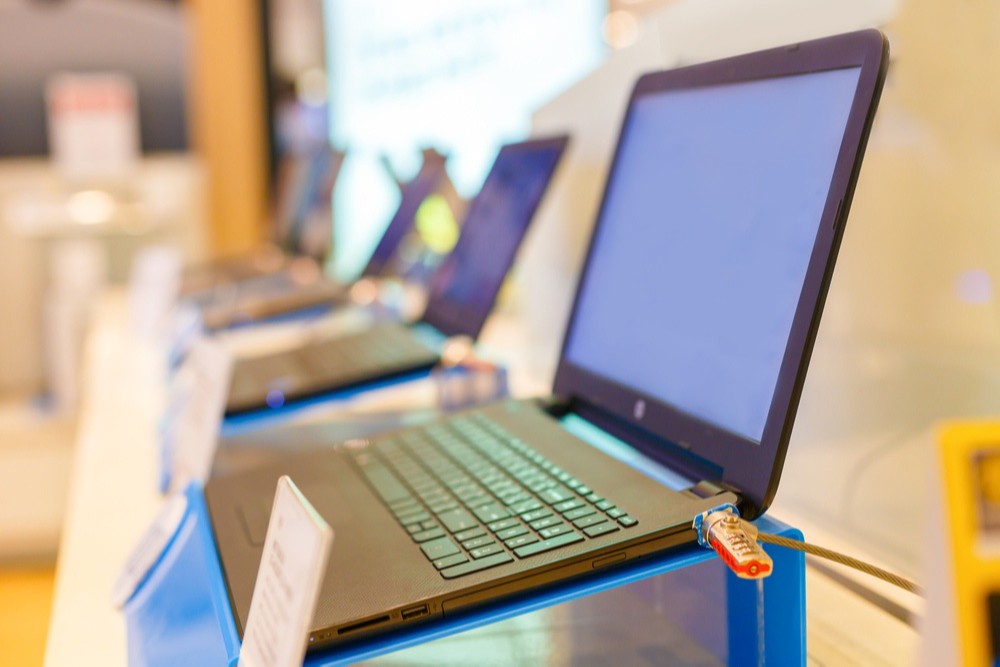Technology isn’t what it used to be. Back in the day, we’d be lucky if a new, faster computer or cell phone came out every few years. Nowadays, it seems like a new smartphone is being released every 6 months and the same goes for laptops. When these new models are released, stores need to get rid of their old laptop inventory and sell it for much cheaper than they cost just months before.
If you’ve ever tried shopping for a laptop before, the massive amount of options might have been overwhelming. In addition to the general hardware specs, there are other things to keep in mind such as weight, battery life, and other choices that are unique to laptops in particular. Should you go with a larger and faster unit, or should you select a portable 2 in 1?
Instead of trying to answer all those questions separately, a good tactic is to pick your use case before everything else. Figure out what you want to do with the laptop first. Are you going to play lots of games on it, or will it strictly be for word processing and some light web browsing? Once you have that settled, you will be able to drastically narrow down your perfect purchase.
What will you be doing on the laptop?
It’s important to remember that unlike a desktop, laptops aren’t very easy to upgrade. Because of that, you should figure out everything you will be doing before you buy a particular model. If you’re a student who just needs something to type up reports and take to class, you could grab a lightweight budget model. Mid-range units with a decent processor and memory will give you more oomph if you are going to be coding and compiling. If gaming or video editing, you’ll want to open up your wallet for something more high-end with a dedicated graphics card on top of a strong CPU.
What features on a laptop are important?
The categories that will matter to most use cases are performance, processor speed, graphics power, weight, battery life, screen size, and budget. If you plan to use your laptop on the go, you might be willing to sacrifice computing power and screen size for lower weight and longer battery life. On the other hand, if this will primarily be used at home plugged in, battery life and weight might not matter at all to you. A dedicated graphics card comes into play if you plan on doing some gaming or video rendering. Speaking of games, you’ll probably also want to spring for a high-resolution screen and ample storage too.
Of course, there are a few things that you’ll want to have no matter what other features you focus on. Among them are:
• At least 256 GB of storage space on a laptop, or 64 GB on a Chromebook.
• At least 8 GB of RAM, or 4 GB on a Chromebook.
• USB Ports to plug in peripherals like your mouse or external hard drives. Be sure to see what type they are too, since most mice will require older USB-A ports and not USB-C.
• A webcam so you can do conference calls or other forms of telecommunication when needed. This is especially important in the world we live in today.
Other options that could be nice but aren’t absolutely necessary are:
• A touchscreen, which will be standard on most 2-in-1s or other tablet-like laptops.
• A keyboard with backlighting so you can type in the dark.
• A screen with at least 1080p resolution.
• A camera with at least 1080p resolution and a decent built-in microphone for video conferencing.
• USB-C charging so you can charge your laptop with a wide range of cables instead of a proprietary brick.
• A microSD card slot so you can add more storage, or easily transfer photos from other devices.
• Modern security features such as facial recognition or a finger print scanner.
• Latest Wi-Fi technologies such as 802.11ax (WiFi-6) so it can take advantage of the newest wireless standards.
Things to avoid when buying a laptop
Everyone loves a good deal, but keep in mind the old adage of “you get what you pay for”. After all, cost reductions have to come from somewhere. You might be sacrificing on features you will end up needing by going with something too cheap. Saving some money now could mean needing to upgrade sooner, which would end up costing you more in the long run.
That’s why it’s so important to really nail down what you will need before you make a final purchase. If you go with a cheaper model with less battery life even though you’ll be traveling around, it could run out of juice at an inopportune time. Not getting enough storage space up front could spell disaster, especially since it’s becoming harder to upgrade the hard drive on certain newer models.
In the same vein, don’t pay extra for things you know you won’t need. If you won’t be doing a lot of gaming or video editing, good graphics on a laptop carry a very high premium. Having the option is nice, but will it be worth hundreds of dollars to you? Going super thin and lightweight when you don’t need to will also add a lot of cost while taking a performance hit. Finally, some premium features are only worth it in fringe cases. Built-in broadband is almost never worth the extra dough unless you know for certain you will need to use the internet in areas with no wi-fi.
Where should you buy your laptop?
There are three choices when you are finally ready to make your purchase. You can either buy online directly from the manufacturer, buy online through an online store like Amazon, or buy in-person from a brick-and-mortar store like Best Buy. Each has their own advantages, and the final choice is ultimately up to you.
If you know what specific model and brand you want, buying direct from manufacturer will give you the most customization options. Or rather, you will have access to pretty much ALL of the options, including ones that might not be available in stores. While going with an online retailer might mean you can’t get certain configurations, you do have access to all of the other brands. That gives you a lot of flexibility.
Finally, brick-and-mortar stores have the least options, but give you an option to try and feel a laptop before buying. This could be important if you want to see how the image quality or viewing angles look in-person, or how the keyboard feels to type on. In addition, it’ll make returns and replacements quicker if you take home a dud or a unit with immediate problems.
As for which of the three will give you the best value, that’ll be up to you to figure out. Sales are constantly going on, and doing your research ahead of time is the only way to save the most possible. In fact, doing your research is probably the most important takeaway of this article. Reading reviews and spec sheets will be able to tell you if you are paying the best price for the laptop that will be perfect for you.
Top Laptop Deals
Acer Swift 3 (2020) – $449.99
Intel i5-1135G7 || 8 GB Ram || 512 GB SSD
Like with cars, companies will start to mark down laptops once new models of the same series come out. The 2020 edition of Acer’s Swift 3 is no different, with the i5 version starting out at below $500. That’s a pretty good price considering that it retailed for at least 800 on release. You’ll score a lot of features that you normally won’t see at this price point, such as good build quality, decent performance, and excellent port selection. Intel’s 11th generation might be a couple years old at this point, but it still has enough power to chew through tasks.
HP 15 (2021) – $299.99
AMD Ryzen 5 5500U || 8 GB Ram || 128 GB SSD
While you might expect to buy a hunk of plastic at the 300-dollar price range, that isn’t the case with the HP 15. Sleek, metal construction surrounds a Zen 2 Ryzen processor along with a zippy SSD hard drive. If you wanted to get some casual gaming in between work or school, the onboard Vega 7 graphics actually performs fairly decently considering its lower price. As long as you keep the resolution and graphic features low on AAA titles, it’ll let you get a quick gaming fix in.
Dell Inspiron 15 3525 (2022) – $539.99
AMD Ryzen 5 5625U || 8 GB Ram || 512 GB SSD
If you have a little more cash to spare, this offering from Dell might pique your interest. Despite having a very similar name to the previous laptop on this list, the 5625U CPU is actually a newer Zen 3 processor. That means more performance and better energy efficiency to get you through the day. You also get a beautiful full HD display with a 120Hz refresh rate that makes the image feel really responsive. Speaking of the screen, Dell’s ComfortView Plus solution blocks out blue light so that your eyes will stay comfortable while getting through longer hours.
Lenovo IdeaPad Gaming 3i (2022) – $729.99
Intel i5-12500H || 8 GB RAM || 256 GB SSD
As any gamer will know, onboard graphics simply can’t compete with a discrete solution. Outfitted with a GeForce RTX 3050 TI from Nvidia, this option from Lenovo will be able to handle quite a bit more than the other notebooks on this list. That’s important when you need to unwind when you aren’t firing off emails or finishing a paper. When you do need to work though, the Intel integrated graphics will keep the battery life from draining too quickly.
Surface Pro 7+ and Surface Pro Type Cover (2021) – $599.99
Intel i3-1115G4 || 8 GB RAM || 128 GB SSD
When it comes to portability, the Surface series has always offered a unique tablet-laptop experience that can go anywhere. The release of the Surface Pro 8 in late 2021 caused the older 7+ model to drop in price, including on the official Microsoft store. While these hybrids don’t normally come with a type cover out the box, you’ll be able to take advantage of this bundle to get both items for one low price. If you’ve always wanted to give the Surface Pro a spin but didn’t like the price, this could be your opportunity.
HP Stream 14 – $299.99
This laptop is a good option for basic tasks such as browsing the web, checking email, and using word processing software. It has a 14-inch display, Intel Celeron N4020 processor, 4GB of RAM, and 64GB of eMMC storage.
Acer Aspire 3 – $399.99
This laptop is a good option for students and light users who need a laptop for everyday tasks. It has a 15.6-inch display, Intel Core i3-1115G4 processor, 4GB of RAM, and 128GB of PCIe SSD storage.
Lenovo IdeaPad 3 – $499.99
This laptop is a good option for students and general users who need a laptop with a bit more power. It has a 15.6-inch display, AMD Ryzen 3 3250U processor, 8GB of RAM, and 256GB of PCIe SSD storage.
ASUS VivoBook 15 – $599.99
This laptop is a good option for students and professionals who need a laptop with a powerful processor and plenty of storage space. It has a 15.6-inch display, Intel Core i5-1135G7 processor, 8GB of RAM, and 512GB of PCIe SSD storage.





